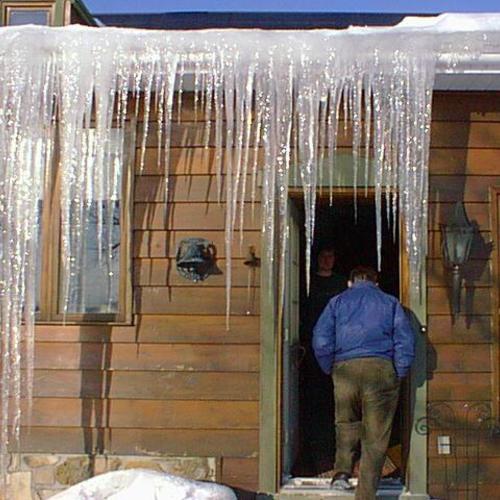
How much is too much when designing a roof for a cold climate where lots of snow is the norm?
Writing from climate zone 7, Michael Sterner says he’s worked with an architect to design a high-performing “Pretty Good House” where snow loads may reach 60 lb. per sq. ft.
As it stands, the roof system will consist of 16-in. I-joists. The assembly will include a 1-1/2-in. deep vent chute below the roof deck—a detail created by nailing plywood to the top flange of the I-joist. Then, dense-pack cellulose will be added to the 14-in.- deep roof cavity. Below that will be an Intello air barrier and a service cavity on the ceiling below.
“In working with an energy consultant on mechanical design, heat load calculations, and ‘redlining’ the building for performance improvement opportunities, they expressed concern over the roof system,” Sterner writes in this recent Q&A post. “The R-value was not high enough (they wanted ‘whole wall’ R-50 with less thermal bridging), and they wanted to see a 2-in. vent chute.”
Sterner’s consultants say they are concerned about the possibility of ice dams along the eaves, and that there are better options available.
“The energy consultants would like me to change to either a lumber or I-joist rafter with plywood and 6 in. of rigid foam on the roof deck, then do 2x rainscreen strapping and a second layer of roof sheathing with underlayment and roofing on top of that,” Sterner says. “I would have to apply the overhangs as outriggers using the rainscreen strapping.”
Should he be worried? Are there, in fact, better roof assemblies than what he has planned? Can he use something less than 6 in. of foam? In short, is it worth the extra effort and hassle?
Those are the questions for…
Weekly Newsletter
Get building science and energy efficiency advice, plus special offers, in your inbox.

This article is only available to GBA Prime Members
Sign up for a free trial and get instant access to this article as well as GBA’s complete library of premium articles and construction details.
Start Free TrialAlready a member? Log in














10 Comments
Ben,
You described air-sealing the 1/4 in. CDX plywood vent chutes here and in a previous Q&A Spotlight. It makes sense to me but I’m wondering how you would detail vent openings in the rim board. I imagine the answer would depend whether the I-joists terminate at a continuous rim board over the top plate, or extend past the top plate and blocking is installed between the I-joists. How was this handled on the roofs you’ve worked on?
Thanks,
Aaron
Has there been any discussion about using an engineered truss in place of the TJI's? It would be an interesting truss design. You could then forgo the center support beam, get a greater insulation depth and maybe a higher ceiling height for the flat portion.
Doug, I would second desiring feedback on an engineered truss design and I am the one the article is written about!
Our basement is going in this week and I've learned that getting the large ridge beam and 16" i-joists in the next couple of months is going to be really difficult. They could not promise me that they'd be able to get them or tell me exactly when.
With that, we've been investigating taking the same roof and converting it to trusses. I've attached what has been proposed thus far. Keeping the slimmer profile to prevent the roof from getting really tall, it relies on a girder truss down the middle and then parallel chord trusses.
I'd especially be interested in understanding if using a truss would actually be better performing or not as good as the original design.
Michael,
You are thinking along the same lines. The parallel chord trusses (16" as proposed) could be deeper to get full insulation. I think you want R-60 minimum. Venting in this area can be accomplished by adding some firing strips under the roof decking attached to the top chord to allow a vent space of 1 1/2 or 2". Then a rigid baffle to enclose the space for adding insulation. I would be interested to know if a single truss can be designed to eliminate the girder truss? This would make the roof framing easier, no concentrated loads and all of the rafter connections. I would push the truss rafter company to explore the available options for the roof system.
Hi Doug,
Thanks for your feedback.
Their first design did have a clearspan truss with no girder truss in the middle. The problem was that instead of 16" like with the i-joist the truss was 24" deep. That's great for insulation but makes the ridge a foot higher and starts to make the building look proportionally strange.
I am trying to find a place to balance the aesthetic with the function and performance.
When using parallel chord trusses I go with the 24" depth minimum. In MN I like an R-65 (minimum) ceiling insulation and this allows for it. A clear span truss will be much easier to work with and less expensive, just a common truss. All of the connections to a girder truss and the fastening schedule if there are multiple girder trusses can be quite labor intensive. I have had roofs where the girder truss (4 units) had to be bolted together on site. I think it was 18 or 24" on center, a lot of work.
A couple of small fairly inconsequential p0ints:
- Continuous vent strips are available in various widths. They don't have to be the factor limiting the amount of ventilated area.
- One of the benefits of deeper vent chutes is the volume of air they contain, not the amount of air they can move. The most extreme example would be a full attic which still only had the same small intake and exhaust vents.
Doug - I wasn't able to reply to you in the nested comment as it was nested too far into the thread.
I would consider the 24" deep truss as it would perform great, however, the height of the roof then makes the bottom of the dormer windows above egress height to clear the roof below the dormer and we're no longer able to have windows of a reasonable height.
I am still trying to figure out what the best course of action is. Another alternative considered was just building with lumber and "building down" into the room to create enough space for insulation. That keeps the building looking lower. We're not pinched for space or anything in there.
Thoughts on any of those options?
Michael,
I misread your plans and now see how the dormers project in the front of the house. I was thinking you had a full height wall across the front, a 2 story in other words. A front elevation or an overhead view in the initial article would have clarified this.
You could lower the roof (reduced slope) in front of the dormers to get the height windows you want. A bit of metal roofing here might work.
My much higher snow load house (125#) is in a high ice dam area not just because of air leakage but because we have so much sun. (6B) We're planning R50+ consisting of 2x6 Rockwool batts in the flat ceiling, WRB/air barrier then 6" Rockwool comfortbatt above. Then a vented hip roof truss system over the top of that. Hopefully that cold roof will be vented enough since it's only 2.5:12
My bigger concern is a flat roof I have on the side of the garage, and a rooftop deck. That's the only place I have significant spray foam and I'm looking into alternatives to get away from spray foam. There's not as much info available on best practices for high performing flat roofs. Any thoughts?
Log in or become a member to post a comment.
Sign up Log in